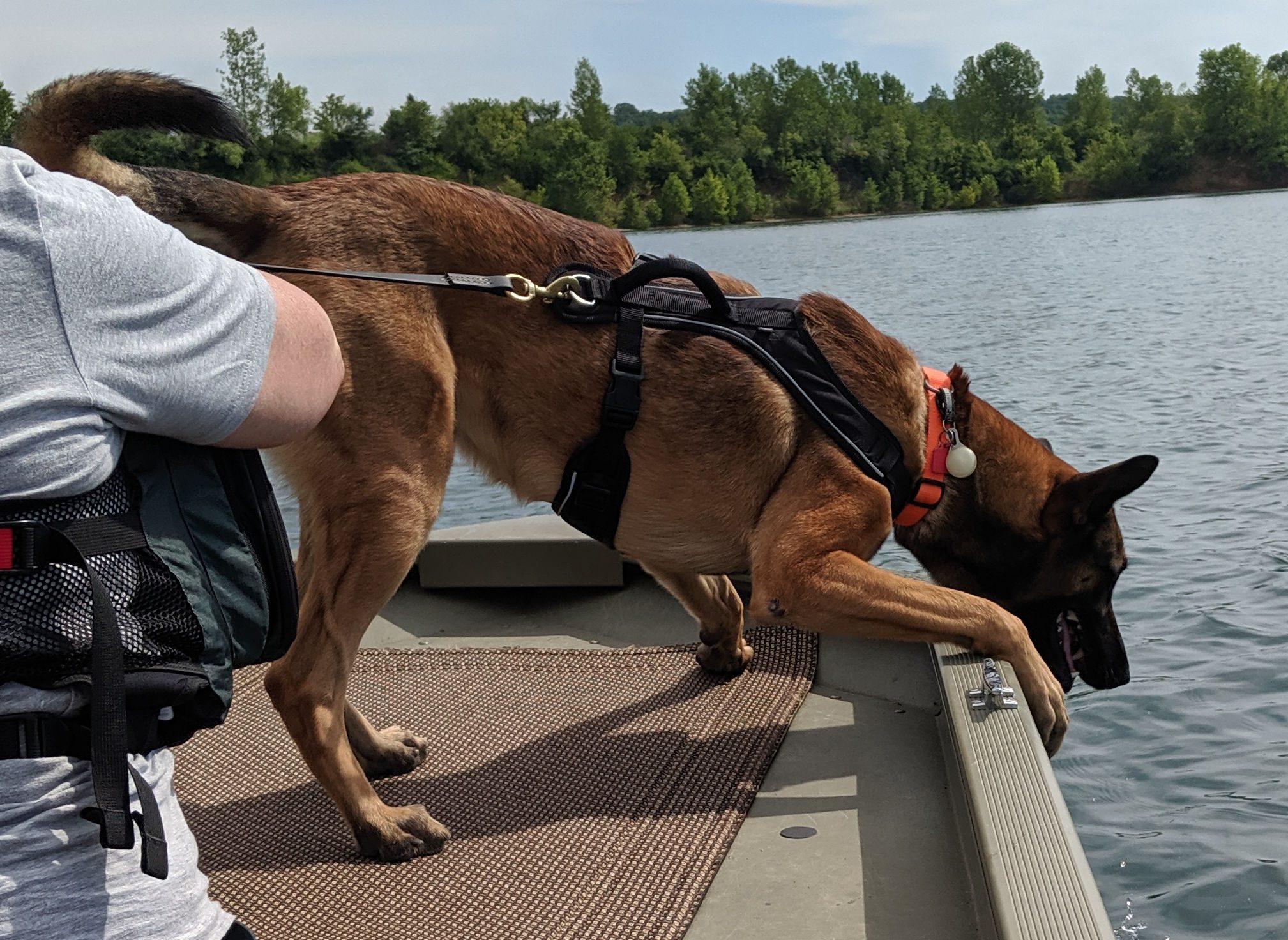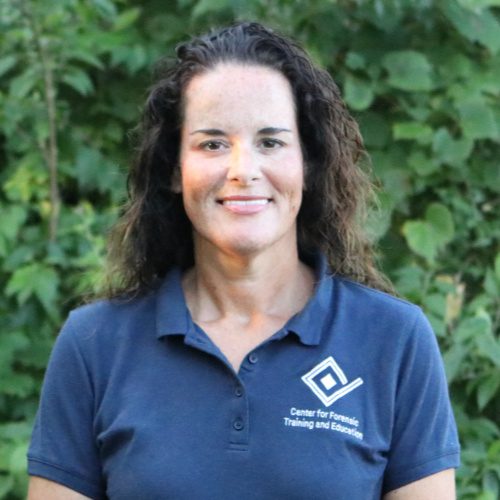K9 Water Training – Where We Go Wrong
HRD Water workshops are among our most requested courses at CFTE. From beginner to operational teams, handlers are always looking for ways to improve their water recovery skills, and more specifically their boat search skills. As a result, we have had the opportunity to work with hundreds of dogs and handlers.

THE PROBLEM
Water is TOUGH! I love teaching and working water more than anything else I train dogs for, but it is by far the most challenging to train and difficult to master. It takes time, patients, resources, and a solid understanding on how odor moves in and on the surface of water under varying condition.
So, what is the biggest issue we see?
False alerts.
Almost every dog, and I do mean EVERY, will false alert in a boat within 15 minutes with most false alerting in 5 minutes or less. I’m not talking about beginner dogs that have never worked odor from a boat before, they don’t have history of odor reinforcement from a boat.
I am talking about dogs that have had at least one exposure to working and being rewarded for odor on a moving boat. It doesn’t matter the type of boat, the type of motor, if the source was large or small, if the exposure was in moving or still water. If the dog has had the experience, they are very likely to false alert.
How do I know this?
Experience. During the past two decades I’ve had the opportunity to work with teams of all skill levels to improve their water search capabilities.
At CFTE, we start all of our Beginner and Intermediate water workshops the same way. First, teams go through an alert station on land to establish that they know odor and have a trained final response. Second, they go for a blank boat ride where there is absolutely no HR in the water so that we can confirm that the dog is comfortable and safe in the boat. In our Advanced water workshop, we start with a long boat ride prior to the dog encountering their target odor. No matter the level of the dog, almost all of them false alert. This is eye-opening for most handlers, especially the operational teams.
THE CAUSE
Difficult Setup
There are areas we see the biggest the issues. First, think about the nature of water training. Compared to land, it is difficult to set up. You can easily set multiple problems on land, run several dogs through and move on the next set up. On water you need to have a boat, an operator, and usually one or two additional people on the boat to set the target odor. If done properly, it is a very time-consuming process and you are limited to how many sources you can set at one time or you will quickly have overlapping scent pools, even in larger bodies of water.
Fewer Repetitions
Water training is time consuming to set up and most teams aren’t training from boats frequently. Since water training opportunities are rare, most or all of your team’s HR handlers want to participate. For larger organizations this could mean 10 or more handlers at one training which means less opportunities per dog.
Short Runs
To accommodate everyone, problems are set close to launch points, boats are driven directly into odor and the dog is rewarded. From launch to landing the dog may only be on the boat for 5-15 minutes, or even less! We are conditioning the dogs to give their trained final response and receive a reward within minutes of getting on a boat.
Unintentionally Cueing The Dog
Even when longer problems are set up, there are cues the dogs pick up on that lead to false alerts. Some of the most common are changes in motor speed, proximity to shore or other visual prop, and handler cues.
A very common false alert trigger is a drop in the motor speed. The boat operator may maintain a higher speed when transporting the team to their search area but drops speed as they approach the target odor.
Proximity to shore or other visual distractions is another culprit. How are you securing your source? If you are tying off rope to shore and running it to the source in the water, chances are your source is pretty close to the shoreline. Your dog becomes keyed into the fact that you are near shore and starts anticipating odor and their reward. Along the same lines you may be tying lines to buoys or other objects in the water. If using divers or a scent machine, then you need to be very careful of bubbles become a visual cue for the dog.
Handler cues can also initiate a false alert. Something as simple as reaching for the reward or directly staring the dog in the eyes when they look to you can cause a false alert. Desensitizing the dog to your movements and actions, along with those of the other people in the boat, is critical.
THE SOLUTION
I’m not going to pretend to have all of the answers, but over the years I have adjusted our water training protocols and it is working for our organization and the teams that come to us for training. The training suggestions below are easy to implement IF you recognize that they are not a quick fix AND you are willing to invest the time.
- Longer boat searches, both with and without target odor present, so that the dog doesn’t develop an internal clock that says they should receive a reward for working a certain amount of time.
- MORE BLANK BOAT SEARCHES!!! Just like on land, searching negative areas is critical. It’s important to be able to read when your dog is in odor versus when they are hunting for odor but don’t have any.
- Take the time to set up problems that eliminate visual cues for the dog. At CFTE, we go through thousands of feet of rope and use several anchors during trainings.
- Work water specific distractions (i.e., buoys, anchors) on land before introducing them on water.
- Desensitize the dog to handler and boat operator movements in the boat.
If you want to see how we train water firsthand, we invite you to join us for an upcoming water workshop (https://thecfte.com/workshops/) or schedule a private small group training https://thecfte.com/customtraining/ for your organization.
Be the first to know about new training opportunities!
Join our email list so we can share information about new workshops and online courses with you!
 Deana Hudgins, CFTE Founder, has been working in Search and Rescue since 2001. She is the Executive Director and a Founding Member of Ohio Search and Recovery Canines. She is also a Canine Search Specialist for FEMA Ohio Task Force 1 working both human remains detection and live find canines. She has traveled the country as an instructor, evaluator, and facilitator for search and rescue classes and workshops. Deana specializes in human remains detection; water, land and disaster, as well as wilderness and disaster live find. She has responded to hundreds of missing person searches for local, state and federal agencies. She frequently consults as a subject matter expert for large scale training exercises and cases, providing guidance in search strategy and planning, resource management, mapping and data collection. During her years as an instructor, Deana repeatedly saw that there was a lack of resources and training opportunities to fully prepare agencies to respond to search and recovery missions. She established the Center for Forensic Training and Education to ensure that any organization involved with the search and recovery of missing persons has access to real world, hands on, custom training opportunities.
Deana Hudgins, CFTE Founder, has been working in Search and Rescue since 2001. She is the Executive Director and a Founding Member of Ohio Search and Recovery Canines. She is also a Canine Search Specialist for FEMA Ohio Task Force 1 working both human remains detection and live find canines. She has traveled the country as an instructor, evaluator, and facilitator for search and rescue classes and workshops. Deana specializes in human remains detection; water, land and disaster, as well as wilderness and disaster live find. She has responded to hundreds of missing person searches for local, state and federal agencies. She frequently consults as a subject matter expert for large scale training exercises and cases, providing guidance in search strategy and planning, resource management, mapping and data collection. During her years as an instructor, Deana repeatedly saw that there was a lack of resources and training opportunities to fully prepare agencies to respond to search and recovery missions. She established the Center for Forensic Training and Education to ensure that any organization involved with the search and recovery of missing persons has access to real world, hands on, custom training opportunities.

